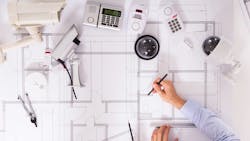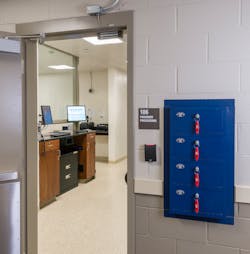Police departments across the country rely on their security and surveillance systems to keep their staff safe within the station, to secure weapons, to secure detainees, to protect the chain of custody of evidentiary materials, and to maintain the confidentiality of the records that the department maintains. It’s important to keep your systems up-to-date and to a level that they offer you a dependable level of protection.
When I designed my first police station 30 years ago, we used small public service windows with thick ballistic, vision distorting, glass. There were bulky cameras with clunky brackets connected via coaxial cable back to CCTV control units in dispatch that were the size of stereo receivers. Exterior cameras were even bulkier in their temperature-controlled housings. The CCTV monitors at the main desk or in dispatch were cathode ray tube units, with small screens and poor resolution. We were lucky to get four images on a split screen of sufficient quality to view from more than a few feet away. When designing a surveillance system in those days, we limited the number of cameras to reduce cost, to minimize monitor real estate, and to simplify control systems.
On the access control side, it took long discussions with police and facilities staff to decide which doors would get the access controls and which ones would not as we balanced the high cost of hardware, installation, and head-end systems against the need for security and accountability.
As an architect, creating a public lobby atmosphere that was appropriate for departments to serve their community when faced with clunky, institutional-looking materials, and devices was challenging.
Today, the technology around security and surveillance systems are much more powerful and discreet. Society has also changed to accept being recorded more often as cameras are in almost all commercial spaces and even within our homes. In the past, cameras were a sign of an unsafe space that needed monitoring, but that is not the case in today’s environment. These changes, along with advancements in materials technology, have altered the character of secure interior design so that we can design lobbies and public spaces that welcome the citizens the department serves while offering an even higher level of security than in the past.
When designing new police facilities, we integrate up-to-date surveillance and access control systems that offer increased security, greater flexibility, robust technical options, and durability against technological change. The surveillance systems for new stations utilize IP based cameras that are networked so users have the flexibility of providing or restricting access to any computer on the network. The image quality of both cameras and monitors have increased dramatically, allowing more flexibility in handling multiple surveillance images on a single monitor or getting more detail when pulling up a single image for closer inspection. Not to mention, flat-panel monitors are larger, offer better resolution, are less costly, and easier to mount. These technological advances provide enough real estate on a monitor to view the images you need.
Affordable, updated tech
According to Moore’s Law, circa 1970, the processing power of computers doubles every two years, while the cost of computers is halved. Some tech industry experts believe the speed of Moore’s Law is reducing or even coming to a halt, but regardless, today we can purchase much more powerful technology at a reduced cost.
Modern cameras are powered over ethernet (POE) and do not require separate power and data connections, thereby simplifying installation and reducing cost. The reduction in camera cost and the installation savings combine to allow a facility to have more cameras with complete and overlapping coverage of the exterior, all entry areas, the public lobby and the corridors throughout the facility. It is also important to have plenty of coverage in the prisoner processing and cell areas to track the complete movement of anyone entering the area, and to provide real-time observation for both officer and prisoner safety.
In many cases, enhanced features are software-based and exist in the head-end equipment rather than in the individual camera. This allows the owner to customize their software package based on the features they need. Video surveillance systems offer many advanced features such as facial recognition and tracking, and license plate recognition to name a few. These features are software-based and do not require a specialty camera, making the customization of the system easy for the owner. Recently, manufacturers have begun offering solutions to address the pandemic by featuring temperature scanning along with occupancy count monitoring, social distance monitoring, and face mask compliance identification. These features are also software-based and can be added to an existing system without the need to change cameras. This is an example of how modern systems can be upgraded immediately via the software system to address ever-changing needs of the department without having to change out the whole system.
There are other valuable features that will require additional hardware at the camera, but the enhanced capability may be well worth the investment. Optical zoom features that are more powerful than the digital zoom on most cameras may be a better option when you want to observe small details at a great distance. On a recently completed police station project, we mounted such a camera aimed at a primary intersection, where it proved to be useful in identifying traffic violations and individuals with open warrants. Cameras with infrared lighting can offer visibility even under very low light situations and 360-degree fisheyes can give a view all the way around the camera, allowing you to see the entire room. Since most cameras are plug and play with a CAT 6 connection, future upgrades are much simpler than in the past. It is important to understand what you are trying to get from your camera and the level of detail that you would like to achieve. A higher-quality camera with some of these features will cost more money but is probably not needed in each location. Often a vendor or installer will put the same camera in all areas if they do not understand the desired outcome from the owner, resulting in either inadequate coverage, underperforming resolution, and/or excessive cost.
When synchronized audio and video recording is required, such as in an interview room or at the booking station, there are specialized systems available that allow you to initiate both audio and video recording with the touch of a button. Files can be viewed live from authorized network computers or saved to share with others or to review later. These time-stamped files can be stored on a separate server from your surveillance files for simplified back-up and greater storage capacity. A simple way to get more capability is to use these systems in conjunction with the regular video surveillance system within the interview room, providing you with different viewpoints of the same interaction. Also, the video surveillance systems will record everything prior and post-interview in case anything was said before the interview recording was initiated.
Access control software has evolved over the years as well. The credentials used to gain access have evolved from old swipe cards to proximity cards and fobs, and encryption technology improvements have made counterfeit credentials more difficult to fabricate. Some modern systems allow the use of smartphones and virtual keys to allow on-going or temporary access to visitors and staff. Multi-factor authentication, which requires more than one credential to access a space, has improved and the hardware costs have reduced over time. Smartphones, fobs, biometric or PIN credentials can be coupled together to provide greater security in areas like evidence rooms and prisoner handling areas. This feature can help departments meet CALEA standards for drugs, weapons, and valuables storage, or just provide increased security around prisoner areas.
The power of access control is in the reporting. The system creates a record of every individual who accesses a door with a time and date stamp. This means that you can determine who had access and when for secure areas like evidence storage rooms, dispatch areas, armories, and equipment rooms. Access control readers within cell blocks can also be used to establish a record for cell checks. This verification ability will provide greater accountability to improve security, enhance evidentiary chain of custody and document your custodial responsibility for detainees.
How can you assess if it is time for a new security or surveillance system?
Ask these key questions:
- Do you have camera blind spots?
- Does your surveillance system offer software upgrades to enhance capabilities?
- Do you have the flexibility to allow monitoring from any computer on the network?
- Do you have sufficient storage for video footage?
- Is your access control system a key or a magnetic swipe card?
- Does your access control system provide reporting features?
- Does your access control system have multi-factor authentication?
- Are your access control and surveillance systems integrated together?
When you decide to upgrade your systems there are a few things to keep in mind. The head-end system is key. The software and the server equipment provide the horsepower to offer options and extend the viability over time. If you invest well in this equipment you can extend the lifecycle of the overall system. Be aware that you may need to consider a licensing fee to be sure you have access to software upgrades and enhancements over time. Be certain that you buy from a reputable manufacturer so that hardware support will continue long after your specific camera model has been discontinued. Also, be aware of the 2019 National Defense Authorization Act that bans certain manufacturers from being installed in federal facilities that could introduce security risks. Be certain that your installer/integrator knows how to work with both systems to get the most capability out of the combined security network. Often, users choose to utilize the same company for both access control and video surveillance systems as this can allow operation of all systems within the same software package. Also, some manufacturers can integrate interview, body, and vehicle systems into the same software package as the access control and video surveillance, allowing all systems to be completely integrated. Make sure that you discuss your wants and needs for the system so your consultant can select the appropriate devices for all spaces.
When upgrading your equipment, it is important to think of your vendor as an integrator rather than someone who sells equipment. You can buy cameras off the internet, but without the programming and the integration of the head-end equipment, you may not have access to the many features a vendor/integrator can offer.
Whether Moore’s Law is still in effect in 50 years or not, it seems likely that integrated software enhancements will continue to give security and surveillance systems increased capabilities for years to come.
Pro Tip: Integrate your access control and surveillance
Jeff McElravy, AIA, Principal, Tecton Architects | AIA, Principal, Tecton Architects
Jeff has dedicated his 34-year career exclusively to architecture for public safety facilities. As a nationally recognized expert in police station design, he serves as a planning and design consultant for departments across the country. For over 20 years, Jeff has been integrally involved in contemporary policing issues as an active member of the IACP Community Policing Committee and Annual Community Policing Award Subcommittee. A Principal at Tecton Architects and the Director of Public Safety Design, he is personally at the helm of every public safety project at the firm.




